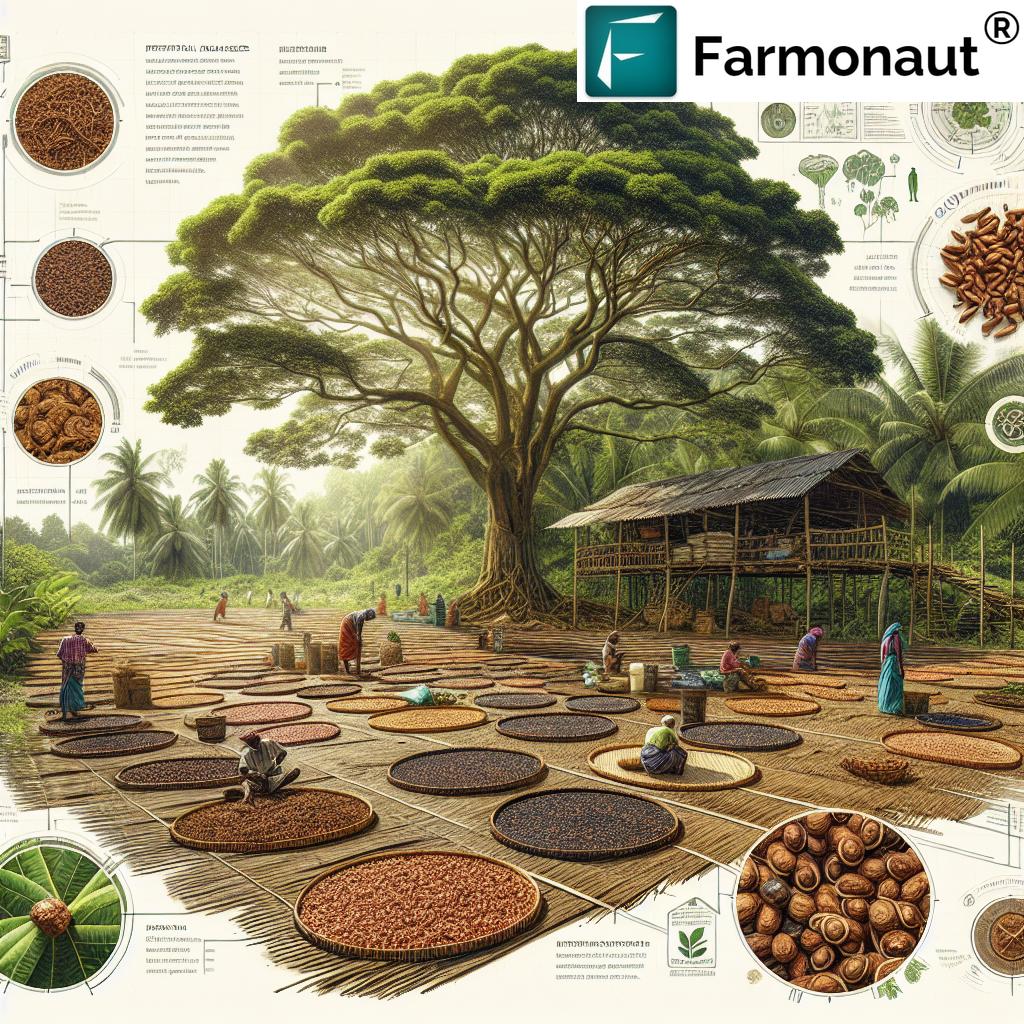Areca Nut: 7 Shocking Sustainable Practices Revealed!
“India produces over 55% of the world’s areca nuts, making sustainable practices crucial for environmental balance.”
Table of Contents
- Introduction
- Cultural Significance of Areca Nut
- Geographical Distribution: Areca Nut Producing States in India
- Essential Cultivation Practices for Areca Nut
- Economic Aspects of Areca Nut Farming in India
- Key Challenges in Areca Nut Cultivation
- Areca Nut: 7 Shocking Sustainable Farming Practices Revealed
- Comparative Summary Table: Sustainable Vs. Traditional
- Farmonaut: Transforming Sustainable Areca Nut Farming
- Conclusion
- Frequently Asked Questions
Introduction
Areca nut, also widely recognized as betel nut, is not just a crop; it is an integral part of various Asian cultures and economies. Sourced from the Areca catechu palm tree – a proud member of the Arecaceae family – areca nut’s journey stretches from India’s lush plantations to bustling local markets where the iconic “paan” is enjoyed. Given India’s role as the global leader in areca nut production, with over 60% share, understanding the interplay of sustainable practices, water-efficient methods, and environmental concerns is more vital than ever.
As our farmers and the agricultural sector face increasing challenges like water scarcity, pest and disease outbreaks, yield optimization, and environmental sustainability, a shift towards sustainable areca nut farming practices becomes imperative. This comprehensive blog post delves into the eco-friendly revolution unfolding across India’s top areca nut producing states—from Karnataka and Kerala to Assam, Tamil Nadu, Meghalaya, and West Bengal—and presents seven shocking sustainable practices that are changing the landscape. Let’s embark on this transformative journey!
Cultural Significance of Areca Nut
Areca nut holds a revered place in the heart of many Asian cultures. Our traditions across India, Sri Lanka, Bangladesh, and Southeast Asia embrace the practice of chewing areca nut wrapped in betel leaves with lime—famously known as paan. This combination not only serves recreational purposes, providing mild stimulant properties, but also symbolizes hospitality, respect, and togetherness in numerous rituals, ceremonies, and social gatherings.
- Betel nut uses and benefits:
- Acts as a mild stimulant, creating feelings of mild euphoria.
- Integral to wedding ceremonies, newborn rituals, and religious functions.
- Used historically as a gesture of greeting, respect, and social bonding.
However, as global conversations around environmental sustainability gain traction, the need to balance cultural practices with responsible areca nut cultivation is at the forefront.
Geographical Distribution: Areca Nut Producing States in India
Let’s explore the regional spread of areca nut farming in India, the world’s largest producer:
- Karnataka – Dominates with approximately 62.69% of national production; major districts include Shimoga, Uttara Kannada, and Chikmagalur.
- Kerala – Second in national output; key regions include Kasaragod and Kannur.
- Assam – The top producer in eastern India, especially in Barak Valley.
- Tamil Nadu, Meghalaya, and West Bengal – Emerging as significant areca nut producing states, contributing to both national and global supply.
This geographical distribution is shaped by optimal climate, soils, rainfall, and deep-rooted cultural practices. Each region faces its unique agricultural, water, and environmental challenges.
Essential Cultivation Practices for Areca Nut
Climate and Soil Requirements
Areca nut cultivation flourishes in tropical climates where:
- Average temperatures range from 24°C to 36°C—ideal for robust growth.
- Annual rainfall is between 1,750 mm and 4,500 mm, although supplemental irrigation is often employed during dry spells.
- Soil preferences: Well-drained, deep, clay loamy soils rich in organic matter.
- Critical to avoid waterlogging; thus, efficient drainage systems are common on most farms.
Planting and Spacing
Planting season: Typically commences with the onset of the monsoon.
Pits: 45 cm x 45 cm x 45 cm filled with topsoil and organic manure.
Spacing: Standard spacing of 3.0 m x 3.0 m accommodates around 1,100 trees per hectare (approximately 400 per acre).
This meticulous arrangement ensures that each areca palm receives ample sunlight, root space, and airflow, reducing disease risk and optimizing eventual yield.
Intercropping: Maximizing Land and Income
Local farmers maximize returns through intercropping, combining areca nut with banana, cocoa, coconut, and black pepper. Intercropping:
- Enhances soil fertility by alternating root depths and nutrient requirements
- Optimizes space utilization in shaded or humid microclimates
- Diversifies income sources, safeguarding against crop-specific market risks
Irrigation, Fertilization, and Water Requirements
Areca nut water requirements are substantial, with each tree needing approximately 15 liters per day during drought—a major reason for groundwater stress in southern India, particularly in Karnataka.
- Efficient drip irrigation: Modern farms use Farmonaut’s large-scale farm management solutions to optimize water use, reduce wastage, and monitor soil moisture with precision.
- Fertilization routines: 100 g nitrogen, 40 g phosphorus, 140 g potassium, and 12 kg organic manure per tree/per year—a blend that maximizes both organic and chemical nutrient incorporation.
In regions with erratic rainfall like Tamil Nadu and parts of Karnataka, drip irrigation and rainwater harvesting are increasingly vital for sustainable yield and long-term viability.
Harvesting and Yield
Areca nut trees begin commercial fruit/nut production after 4-5 years. Harvesting is manual: nuts are plucked when three-quarters ripe—typically yielding 3 to 6 harvests per year, depending on the local season and region. Average areca nut yield per tree can reach 4.5-5 kg yearly under optimal conditions.
Economic Aspects of Areca Nut Farming in India
In places like Karnataka, areca nut cultivation is not just a tradition; it’s big business. Let’s break down the economic model:
- Average yield: 4.5 to 5 kg nuts per tree per year, with mature plantations hosting 400 trees per acre
- Market price: INR 250 per kg (as of the most recent data)
- Gross annual income per acre: Upwards of INR 5,00,000 – but actual profits vary based on input costs, water, pests, and diseases management
While lucrative, high input costs for water, fertilizers, pesticides, and disease control threaten net income and highlight the urgency for sustainable farming methods.
Key Challenges in Areca Nut Cultivation
Water Usage and Environmental Impact
Areca nut water requirements pose significant challenges for farmers, especially in semi-arid and drought-prone regions:
- Each tree requires up to 15 liters per day in dry periods, causing intense pressure on groundwater reserves.
- Unsustainable watering can lead to water depletion, soil degradation, and decreased farm productivity long-term.
- Improper drainage or excessive waterlogging severely impacts root health and crop survival.
Pests and Diseases
Areca nut pests and diseases are a constant threat to yield and farmer livelihoods:
- Fruit rot, yellow leaf disease, and bark decay represent major challenges in Karnataka and Assam.
- Outbreaks can slash yields, degrade quality, and increase dependence on chemical pesticides, which in turn harm local ecosystems.
Coping strategies must blend integrated pest management (IPM) with judicious organic and chemical interventions to minimize losses.
Soil Fertility and Chemical Dependency
Continuous use of chemical fertilizers and non-organic pest control leads to:
- Soil health issues: Degradation, reduced microbial diversity, and long-term fertility decline
- Environmental pollution: Runoff into local streams and water bodies, impacting broader ecological balance
Addressing these challenges is central to the future sustainability of areca nut farming in India.
Areca Nut: 7 Shocking Sustainable Farming Practices Revealed
“Water-efficient areca nut farming can reduce irrigation needs by up to 30%, conserving thousands of liters per hectare annually.”
Let’s dive into the seven game-changing sustainable practices revitalizing areca nut cultivation across India’s tropical landscapes:
-
Adopting Organic Farming Methods
Replacing synthetic fertilizers with organic manure (such as compost, green manure, and farmyard manure) revives soil health, enhances nutrient cycling, and promotes resilient plants. Areca nut organic farming minimizes chemical runoff, preserving local water bodies and supporting sustainable yield.
Benefits: Healthier soil, reduced input costs, improved environmental outcomes. -
Integrated Pest Management (IPM) Strategies
Integrating biological, mechanical, and cultural measures with strategic pesticide use keeps areca nut pests and diseases in check. ♻️ IPM uses methods like introducing predator insects, using trap crops, and encouraging plant diversity to naturally control outbreaks.
Benefits: Reduces chemical use, maintains ecological balance, lowers pest incidence. -
Implementing Drip Irrigation and Water Conservation
Drip irrigation delivers water directly to tree roots, reducing evaporation losses by as much as 30%. Rainwater harvesting, mulching, and careful scheduling further reduce areca nut water requirements.
Benefits: Cuts water usage, protects against drought, maximizes efficiency. -
Utilizing Areca Nut Waste as Mulch
Recycling areca nut husks for mulching conserves soil moisture, enriches soil organic matter, and naturally curbs weed growth. This sustainable practice also helps reduce input costs on synthetic fertilizers.
Benefits: Boosts soil fertility, conserves water, reduces reliance on chemicals. -
Intercropping with Compatible Crops
Strategic intercropping (e.g., banana, black pepper) diversifies income streams, improves resource use efficiency, and strengthens resilience to climatic or market fluctuations.
Benefits: Optimizes land and water use, buffers farmers economically, enhances pest control through crop diversity. -
Precision Farming & Crop Monitoring
Leveraging technologies like Farmonaut’s satellite-based crop monitoring helps farmers track soil moisture, irrigation needs, pest outbreaks, and crop health in real time. This data-driven approach ensures timely interventions while reducing waste and maximizing yield.
Benefits: Improves productivity, conserves resources, supports long-term sustainability goals. -
Transition to Blockchain-Based Product Traceability
Introducing blockchain-based traceability in areca nut supply chains promotes transparency, authenticates eco-certification, and builds consumer trust. This is especially relevant as global buyers increasingly demand verified sustainable and environmentally friendly produce.
Benefits: Reduces fraud, enhances market access, incentivizes sustainable cultivation practices.
Comparative Summary Table: Sustainable Areca Nut Practices vs. Traditional Methods
| Practice | Estimated Water Use (liters/acre) | Pest Incidence (%) | Average Yield (kg/acre) | Input Cost (INR/acre) | Environmental Impact |
|---|---|---|---|---|---|
| Traditional Areca Nut Cultivation | 1,000,000 | 20% | 1800 | ₹80,000 | High CO₂, declining soil health, water depletion |
| Organic Fertilization | 900,000 | 17% | 1700 | ₹60,000 | Improved soil health, less chemical runoff |
| IPM (Integrated Pest Management) | 950,000 | 10% | 1850 | ₹65,000 | Lower pesticide use, better biodiversity |
| Drip Irrigation | 700,000 | 17% | 1900 | ₹72,000 | ~30% water saving, stable yields |
| Mulching with Areca Nut Husk | 750,000 | 16% | 1950 | ₹62,000 | Reduced soil erosion, less evaporation |
| Intercropping | 900,000 | 15% | 2000 (plus intercrop yield) | ₹68,000 | Enhanced biodiversity, higher income |
| Precision Satellite Monitoring | 700,000 | 8% | 2100 | ₹74,000 | Data-driven decisions, CO₂ reduction, less resource wastage |
| Blockchain Traceability | 900,000 | 15% | 1900 | ₹75,000 | Market access, enforced sustainability, eco-labelling |
Farmonaut: Transforming Sustainable Areca Nut Farming
Embracing sustainable areca nut farming practices is no longer a dream but a necessity. Farmonaut is at the forefront, leveraging advanced satellite imagery, AI-driven analytics, and blockchain-based tools to help farmers achieve:
- Real-time crop health monitoring – Spot pest or disease outbreaks, manage water and fertilizer requirements at the right moment using Farmonaut’s crop health monitoring.
- Resource-efficient farming – Minimize water usage, input costs, and maximize areca nut yield per tree with precision insights via a user-friendly app and web platform.
- Environmental responsibility – Quantify and reduce carbon footprint (see Farmonaut Carbon Footprinting), adopt eco-friendly practices, and enhance traceability for global markets.
By adopting Farmonaut’s solutions, our farmers future-proof their areca nut plantations for decades to come, ensuring balance between economic growth and environmental stewardship.
Explore more about how Farmonaut supports satellite-based API-driven farm management and check out our comprehensive developer documentation for agri-tech professionals.
If you are interested in large-scale areca palm plantation monitoring or need tailored forest/crop advisory, visit our Crop, Plantation & Forest Advisory service for the next-level insights.
Improve your supply chain assurance through Farmonaut Product Traceability, delivering blockchain-backed transparency, product verification, and eco-labeling for areca nut and allied products.
Conclusion
Areca nut—the pride of Indian agriculture, cultural tradition, and rural economy—is at a crossroads. The path forward demands a marriage of heritage with innovation, tradition with sustainability. As water scarcity, soil fertility, pest outbreaks, and environmental challenges mount, it is our collective responsibility to prioritize sustainable areca nut cultivation practices: from organic farming and IPM to embracing precision agriculture, water conservation, and blockchain traceability.
With Farmonaut’s affordable, data-driven solutions, our farmers across Karnataka, Kerala, Assam, and beyond are better positioned than ever to maintain high yields, healthy soils, and vibrant communities—while safeguarding our planet for generations. The areca palm’s legacy is bright when nurtured by science, stewardship, and cultural respect.
Ready to transform your areca nut farm? Download Farmonaut’s app, harness data, and lead sustainable agriculture in your community.
Frequently Asked Questions
Q1: What is areca nut used for?
A: Areca nut, commonly known as betel nut, is mainly chewed with betel leaves in rituals, ceremonies, and social occasions. It has stimulant properties and is central to cultural traditions across many Asian societies.
Q2: Where is areca nut mostly cultivated in India?
A: Major areca nut producing states in India are Karnataka, Kerala, Assam, Tamil Nadu, Meghalaya, and West Bengal, with Karnataka contributing the largest share.
Q3: How much water does areca nut farming require?
A: Each areca nut tree requires around 15 liters of water per day during dry spells, making it a water-intensive crop. Efficient irrigation like drip systems can save up to 30% water use.
Q4: What are the main pests and diseases affecting areca nut cultivation?
A: Key threats include fruit rot, yellow leaf disease, and bark decay. Integrated pest management (IPM) and regular monitoring can help control outbreaks.
Q5: How can I make areca nut cultivation more sustainable?
A: Adopt organic fertilization, IPM, drip irrigation, mulching, intercropping, precision agriculture with satellite monitoring, and ensure blockchain-based product traceability.
Q6: How does Farmonaut support sustainable areca nut farming?
A: Farmonaut provides affordable satellite-based crop health monitoring, AI-advisory for irrigation, pest prevention, carbon footprint tracking, and supply chain traceability to boost farm productivity and sustainability.
Empower your areca nut journey with precision, sustainability, and transparency—powered by Farmonaut!
















